
From Giant Bomb.
In 1978 the author Mitsuru Sugaya debuted one of the first videogame-themed mangas, ゲームセンターあらし (Game Center Arashi).
The title character, Arashi, aimed to beat various competitors at arcade high scores.
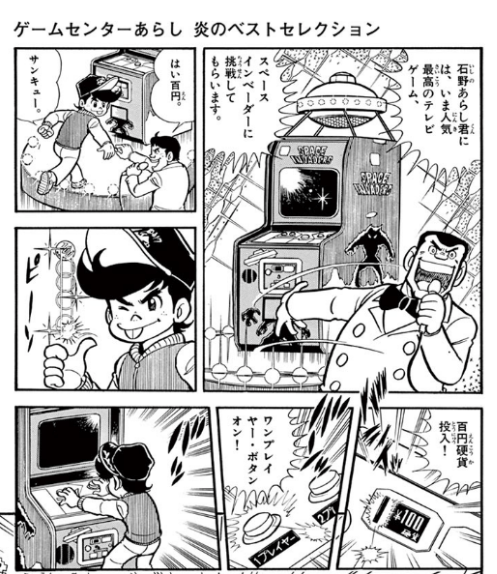
From the first issue.
Prominent games like Space Invaders (above) and Galaxian were featured. In a later spin-off feature, the author produced a series of two volumes, Hello Microcomputer, which taught readers both about how computers worked and how to code. The volumes sold incredibly well, over half a million copies; according to the author, some who got careers in the computer sector were inspired directly by the books.
The second volume included a section dedicated to a game called Mystery House; not the one by Roberta Williams, but the one directly inspired by her work released in 1982.
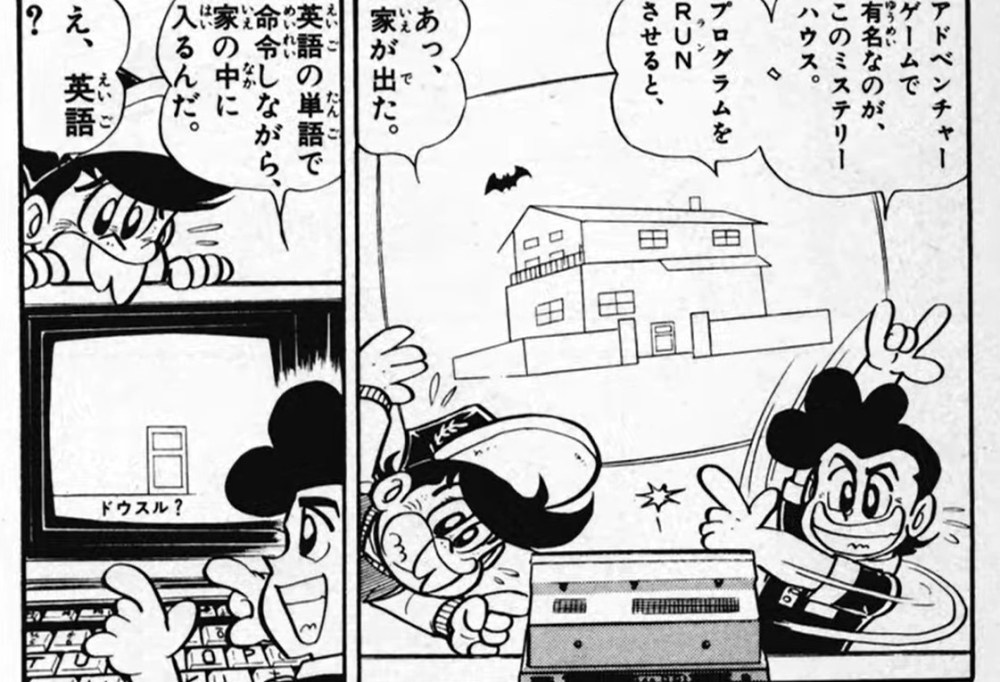
From a video by Bowl of Lentils about Mystery House.
As mentioned in my post on the first Japanese adventure we know of, Omotesando Adventure, hobbyists in Japan imported games from the US and played them with dictionaries, so they were well aware of the early Sierra works. The Hello Microcomputer issue with Mystery House even includes a section on imported games, like Time Zone. (Based on the December 1982 issue of LOGiN Magazine, the top-selling Sierra import was Softporn Adventure.)
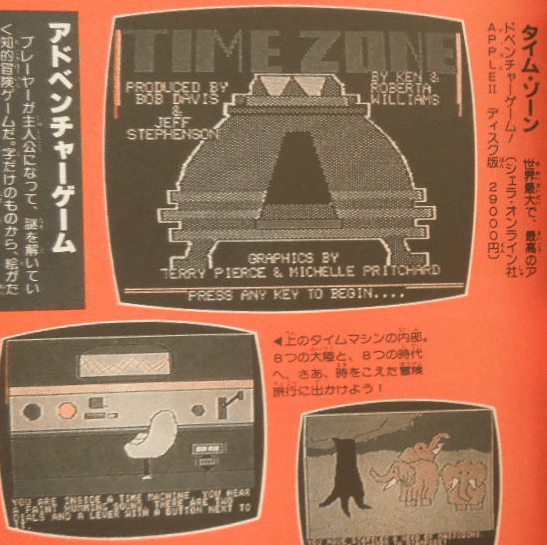
From Yahoo! Auctions. The price of 29000 Yen is roughly comparable to the $100 the game cost in the US, which in 2022 dollars is a little over $300.
The 1982 work was originally by Tsukasa Moritani, a dentist and regular visitor to the electronics/computer store Micro Cabin Yokkaichi.

He showed it to the owner Naoto Oyachi, who was impressed enough to work with Tsukasa to produce a publishable product.
The final work was for the Sharp MZ-80B (released in May) did well enough — spawning a sequel before the end of the year — that it was ported to multiple machines and was the basis for the general launch of Microcabin as a software company. Microcabin became one of the big Japanese game publishers, lasting all the way until the 2000s.
I am not going to play the Sharp version, although if you want to see it (and hear its rendition of the Pink Panther Theme) I’ve linked the relevant spot in the Bowl of Lentils video. I didn’t have a choice. That version is undumped.
I at least started to try the NEC PC-6001 version, which has a translation patch to be able to play in English. (As far as why I didn’t keep going, I’ll explain in a moment.)

The Pink Panther theme also plays on this version, and it is there because this game drops the “murder” aspect and just keeps the “find the treasure in a house” aspect, making it a diamond. The original Pink Panther movie surrounded a stolen diamond.
Mind you, the game is already partially in English; while the text output is in Japanese, the parser is in English. There’s a helpful guide card that gives translations of each of the words needed. Additionally, the verbs and nouns are separated, so they get typed on separate lines (that is, you can’t type OPEN DOOR, but OPEN. followed by hitting enter, then DOOR, then enter again).

What I discovered after enough testing is that there are two very different versions of Mystery House’s gameplay. The original Sharp version (and some other versions like Fujitsu FM-7) are “traditional” in that they use compass movement commands typed on the parser. The PC-6001 version (the one I started with) and the MSX version both use arrow keys for movement (that is, the N/S/E/W on the card above don’t apply).

An interior shot of the PC-6001 version.
In all versions, the game keeps track of what direction you are facing. In the Sharp and FM-7 versions if you type W for west but aren’t facing that direction the game will simply turn you that way. If you are facing that direction then the game moves you forward. The arrow-key games on the other hand will either turn you (if you press left or right) or move you forward (if you press up).
It is possible to get go up some stairs and then type DOWN to immediately go back down and get denied. That’s because the stairs are “behind” the player — you have to turn so they are visible, then go downstairs. (You can watch a video here of this happening to a real player.) In a way, the PC-6001 and MSX versions are simplified in this sense. Stairs can only be clearly seen in facing the “correct” direction so it makes a bit more intuitive sense that you can’t go DOWN again right away.
The graphic system feels both crude and intensely complicated at the same time. There’s a limited set of object graphics that get reused to form rooms, rather like Castles of Darkness; so unlike the Sierra games, it isn’t like there’s a custom room for each location. But the game needed the logic to draw the objects correctly as if traveling through a 3-D world; Deathmaze 5000 and some related games did something similar, but in a mostly wireframe format! Despite the clear inspiration, I find any characterizations of 1982 Mystery House to be just a knockoff of 1980 Mystery House to be misplaced; it clearly is doing its own thing both in a technical sense and a gameplay sense.

Alas, the interface on the PC-6001 version was just miserable to navigate. The parser is contained on a separate screen from the main graphic window so you have to keep switching back and forth. Every time a new graphic shows up, you need to hit “space” to switch to the command typing screen, then type out what might be a valid command (see above). If instead of a typed command you need to move, you go to the same typing screen, push a direction, then push it again (for some reason?) to actually do the move. It is very easy to get lost even in a handful of rooms.
I tried very hard to make it work — I even hooked a gamepad with macros for movement to try to make things smoother — but it was just too heavily grating to deal with. I finally decided to switch to the slightly more colorful FM-7 version. All commands are on the same screen as the graphics, and I found it genuinely easier to type W to turn rather than hope the janky arrow keys worked. Even though the direction commands are “overloaded” with them either turning or moving forward based on context, I never got confused moving around. (Based on the footage of the Sharp version, the FM-7 version is more authentic to the original anyway.)


That means, yes, I intentionally dropped playing the English version of the game to switch to Japanese! There really isn’t much Japanese to deal with and everything being graphical means you can puzzle out the action on screen. The only part I got confused is when I tried to climb a ladder and died, but — well, we’ll get to that.

(On the screen above, going “east” means “forward”. The compass in the upper right fortunately is enough to keep things straight.)
Exploring around the ground floor, I found a safe (from MOVE PAINTING) which was locked, a candle in a RACK, and a match in a RACK.

(RACK is a weird word — I want to use cabinet. The player in the video I linked earlier also tried to use CABINET first. I had one eye on the instruction card while I was playing, though, so I knew which nouns worked.)
Poking around the second floor eventually yielded a key sitting on a chair (via SEARCH CHAIR) and a key sitting in a flower vase (via SEARCH VASE).

This is a “two-square wide” room, so you can step forward to get closer to the flower vase, then SEARCH VASE to find a key inside.

The screen above shows going forward one step from the previous screen.

Once I got the hang of things it felt a little like the movement in a dungeon-crawler like Wizardry. Since Wizardry had already been imported, I wonder if it was also an influence.
The keys let me open the safe (which contained a hammer) but make no other progress. However, I hadn’t tried MOVE on anything other than the painting, so I went on a MOVE spree (and was told NO! a lot, the game writes it in English) before finding a movable table.

This leads down a dark ladder where you can die without a light source. Of course, I already had a match and candle so I could normally easily resolve the puzzle, but it took a couple tries to realize the game wasn’t keeping track of the candle as a “long term light source” like Adventure or its clones — it was an object that needed to be activated while on the ladder itself. If you light before going down it doesn’t work.


The second key I had goes to this “rack” and yields up some oil. This let me USE OIL on a cabinet, I mean, rack that was being finicky upstairs and find a new secret area.


The “attic floor” was very small and the only thing I could find (inside a rack which required a hammer to bust open) was a pick (like the kind you mine with) and a ladder that means death.

(I found out after the fact the Japanese indicates that you get up to the roof and fall. This is similar to a death from the original Mystery House.)
There’s a genuinely clever moment here, although I needed to check a walkthrough (by the ever-helpful くしかつ Kushikatsu) to figure it out. The ladder can be moved, and the spot behind the ladder is holding a secret (which is what the pick is for).

This leads to a new area with a key (just laying out on another chair) but where I was otherwise stumped. I had to do something clever with a fireplace but I needed the walkthrough again. You can light the fireplace.

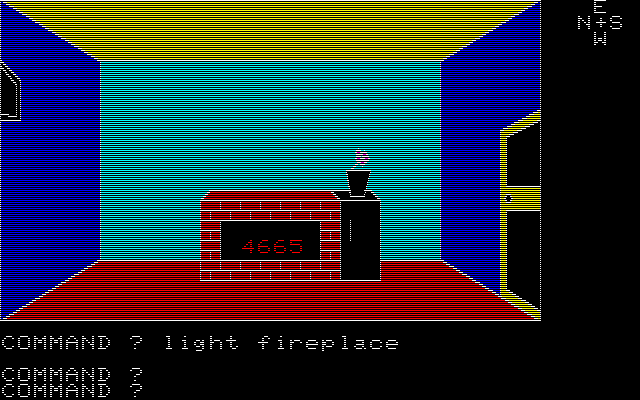
Ah-ha! But where does this code go? It turns out: back to the dark basement. Remember that rack with the oil? It can be moved.
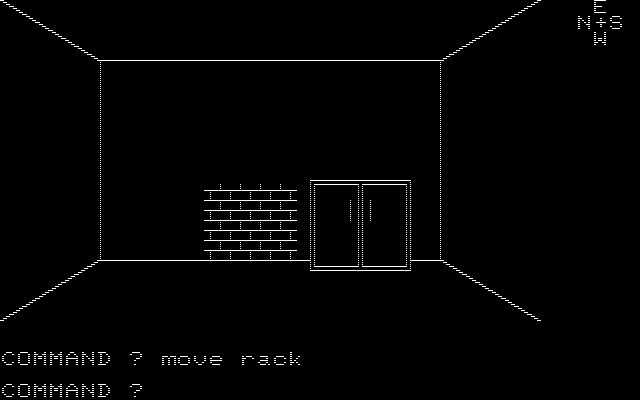
USE PICK then works here.

(One last trick: 4665 doesn’t work. You need to type in the number backwards.)
I admit I was originally skeptical this was just going to be a find-the-key hunt in the end — there are, after all, only a small number of verbs and graphical elements. However, the slight twists like the passage in the rack, the passage behind the ladder, and the code in the fireplace elevated the game up into having something approaching a real plot, even if you were just trying to find a diamond. I mean, er, gold.

(This video walkthrough of the PC-6001 version definitely gets a diamond. The Pink Panther music also doesn’t make sense without the original Sharp version having a diamond. For some reason the FM-7 changed the treasure to gold.)
I will at least plead for anyone else who writes about this game: yes, Dr. Moritani clearly was inspired by the Roberta Williams Mystery House. However, discarding it as just a knock-off (and just a stepping stone to the game people really want to talk about, The Portopia Serial Murder Case) really doesn’t make sense; the navigation is truly novel, the puzzles go in a completely different direction, and the graphics are built off of repeating elements meant to be viewed in a 3-D setting.
I should also add there was almost certainly inspiration from one other game. In some cases if do something the game doesn’t understand (usually referring to an item that isn’t in your current “view”), you get the cryptic message “Nothing to mean.” This is a very unusual and unique message, and it appears in only one other game: Omotesando Adventure. Clearly Dr. Moritani had played more than one adventure, including Omotesando, so we have a true continuity of game influences.
There are also two sequels to Mystery House (one which came quite quickly on the heels of this one) but while I wanted to play Omotesando and this game close together, I’m going to give a longer pause before hitting Mystery House II. Never fear, there’s plenty of interesting territory out there to explore, including my next game, which I can only describe as “incredibly enigmatic”.
Now I’m curious: What kills you if you try to climb the ladder in the attic? Do you bang your head too hard on the underside of the roof?
According to a japanese speaker on the Gaming Alexandria discord, you climb up to the roof and fall off. (To be fair this happens in original mystery house too! There’s a scene in that one w an ambulance.)
The color in the FM-7 version is quite striking, despite its simplicity. I like it.
From what I can read of that manga image, he’s saying its a famous adventure game, (probably the original) and that you play in English. I think the guy in the leftmost panel is expressing shock at this. “Eh? English?” I don’t understand what the third line of the right text box there is, but the rest seems to be “you need to know English to enter the house.”
Also, LOL that the top import was Softporn Adventure. Guess despite their best efforts that was always their game with the best market penetration.
I played the game briefly a year or so back, don’t remember the version and I remember finding the game’s parser really weird. I already figured out that Japanese games would always have a weird way of doing text, but the whole action, then object thing tripped me up.
As to the movement thing, remember, this is back in the day when the line between adventure and RPG was muddled. As I’m sure you’ve noted, there are two weird RPG/adventure games that came out of Japan around the same time that also used a Wizardry-ish way of moving around. Seems like the movement scheme was a good idea in concept even if it didn’t work out.
The fm-7 just has you type commands normally (no separate noun/verb commands) so if you ever feel like a revisit I would recommend that one.
Jason, I wonder if you have taken any kind of structured notes during the process of this project that you might share with us? Something like a rating system, difficulty estimation, category (story-driven, puzzle-driven, …), hidden gems, top 5 of each year, etc.? I’d love to play a few of these but only the ones worth it… :)
https://bluerenga.blog/2021/12/20/all-the-adventures-up-to-1981-in-review/
Pingback: Kabul Spy (1982) | Renga in Blue
Pingback: Mystery House II (1982) | Renga in Blue